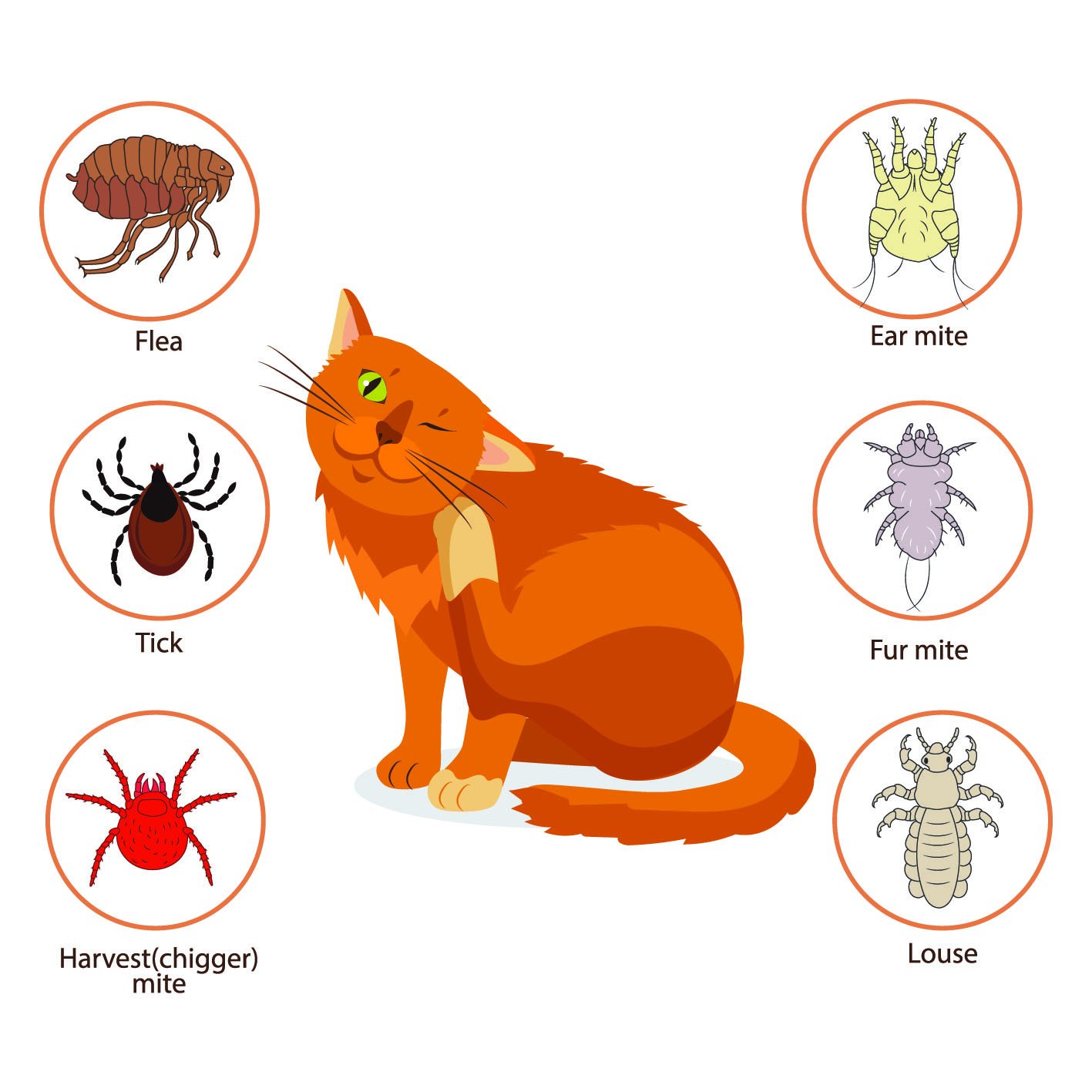galitskaya | DepositPhotos

Skin problems are frustrating for cat owners. Itchiness and discomfort, with symptoms ranging from constant scratching to irritated skin to hair loss, can be caused by a wide variety of conditions. This makes diagnosis challenging and sometimes expensive. We consulted William Miller, VMD, DACVD, Dermatology Section Chief at Cornell University College of Veterinary Medicine for insight on the things that can make your cat’s skin crawl.
Parasites
“The number one cause for itching and its associated hair loss (fur mowing if the cat is an over groomer) is flea-related, if the cat lives in a flea-infested area and adequate flea control isn’t used,” says Dr. Miller. Flea-allergy dermatitis is an allergic reaction to flea bites. Affected cats can have severe reactions even with only a few bites. The classic presentation is the presence of red, irritated skin with crusty bumps around the cat’s rear end and/or on her abdomen and neck (these are the most popular spots for fleas to feed). The cat may also have scratch wounds from scratching at the lesions with her claws.
Flea-allergy dermatitis is generally diagnosed by the clinical signs. However, as even a single flea could cause the cat to have a reaction, finding a flea is not required. Treating flea-allergy dermatitis requires diligent flea control for all pets in the household year-round and ideally keeping the affected cat indoors to minimize flea exposure. Your veterinarian may also prescribe medications to minimize the severity of the symptoms or promote healing of damaged skin, but keeping fleas away from your cat is vital.
And fleas aren’t the only bug that might be bothering your cat. “In certain parts of the country (mostly down south), infection with the contagiousDemodex gatoimite is a reasonably frequent cause for itching,” says Dr. Miller.”[Another] typically southern external parasite would be feline scabies (Notoedres cati) or the fur mite.”
Mites can be found by doing a skin scrape, or dragging a scalpel blade sideways across the cat’s skin to dislodge skin cells and the mites living there. The skin scraping is then examined under a microscope. Even if mites are not found in one skin scraping, your cat may still have a mite infection, so your veterinarian will consider all clinical signs and not depend solely on the skin scraping to make a diagnosis.
Ringworm is a fungal skin infection. Ringworm usually presents as circular areas of hair loss that may also be itchy. It is generally treated by applying topical antifungal medications to the affected areas. Oral medications are often used as well. Treatment can take six weeks or more. Note that ringworm can be spread to humans. If you are suspicious that your cat has ringworm, seek veterinary attention promptly and avoid touching the affected areas on your cat.
Environmental Allergies
“When external parasites are off the list, atopy or food allergy come next,” says Dr. Miller. Atopy refers to environmental allergies, such as to pollens, ragweed, or dust. Symptoms include itching and scratching, biting at skin, lesions, ulcers, and hair loss, and the cat may also show signs of ear and/or respiratory infections. Symptoms can be seasonal, as with allergies experienced by many humans, or may be present year-round. Dr. Miller also warns that some cats “start out with [a] mild seasonal itch that eventually becomes year-round and the level of the itching increases dramatically.”
Diagnosing atopy can be frustrating. Allergy testing can be done by testing the skin or serum from your cat’s blood. These results can then be used to formulate an immunotherapy solution containing the antigens that your cat responds to. Immunotherapy is tailored to your individual cat’s needs but can take several months to yield relief.
A skin biopsy can also be useful to make a diagnosis, as can testing if the cat responds to steroids and/or antihistamines. These medications can be used as treatment, either in conjunction with immunotherapy or on their own.
Food Allergies
Food allergies are an immune response to a particular ingredient in the food. The most frequent offenders are protein sources, such as chicken. The most definitive way to diagnose a food allergy is to adhere to a strict food trial by completely removing the suspect ingredient from your cat’s diet for several weeks and then reintroducing it. If that ingredient was the problem, your cat’s symptoms will go away during the trial period without the suspect ingredient and return when the ingredient is added back in.
Food trials are difficult because they require monitoring not only the cat’s main diet, but all treats and table scraps she might get. There is no guarantee that the first ingredient removed is the actual culprit, so it may take several trials to get an answer.
The good news, however, is that as long as the problem ingredient is avoided, your cat will be comfortable and healthy.

Behavioral Over-Grooming
Dr. Miller says, “Although people talk of behavioral over grooming, it is actually very rare to nonexistent in the otherwise sane cat.If the cat has separation anxiety, litter-box issues, etc., then over grooming might enter the picture.” These cats may have hair loss due to their excessive grooming habits, but generally lack the other signs of skin problems.
Seeking Treatment
“The owner should always give their primary-care veterinarian several shots at diagnosing and treating the condition,” says Dr. Miller. Many different skin problems manifest with the same clinical signs, so it can take some experimenting to figure out what is actually causing the problem. “If the same treatment is used over and over again and it’s not effective enough, it’s time to seek a second opinion.” If available, a board-certified veterinary dermatologist can be a valuable resource for owners of cats with chronic skin problems.
Don’t be tempted by home remedies that claim they will resolve itching. “Few, if any, home remedies that are safe for [cats] do much to control itching,” warns Dr. Miller. “The veterinarian is the best person to help the cat.”
Prevention
Good parasite control is the first step toward keeping your cat’s skin healthy. Keeping your cat indoors limits exposure to parasites, but indoor-only cats can still get fleas (see “Yes, Your Indoor Cat Can Get Fleas,” June 2018, at catwatchnewsletter.com). Normal grooming also helps to keep your cat’s coat and skin healthy. Keep her thin and fit to allow for adequate grooming.
Common Treatments for Environmental Allergies
– Steroids, such as prednisone, which are potent anti-inflammatory drugs with a range of side effects
-Antihistamines
-Cyclosporine, an immunosuppressant
-Omega-3 and omega-6 fatty acids, supplements that replenish essential oils in the skin and decrease inflammatory molecules
Diagnostics
-Skin scraping to look for mites
-Using a flea comb to check for fleas
-Blood tests for allergies
-Food trial for food allergies
-Intradermal allergy testing
-Skin biopsy
-Trial run with a steroid or antihistamine to see if it helps




